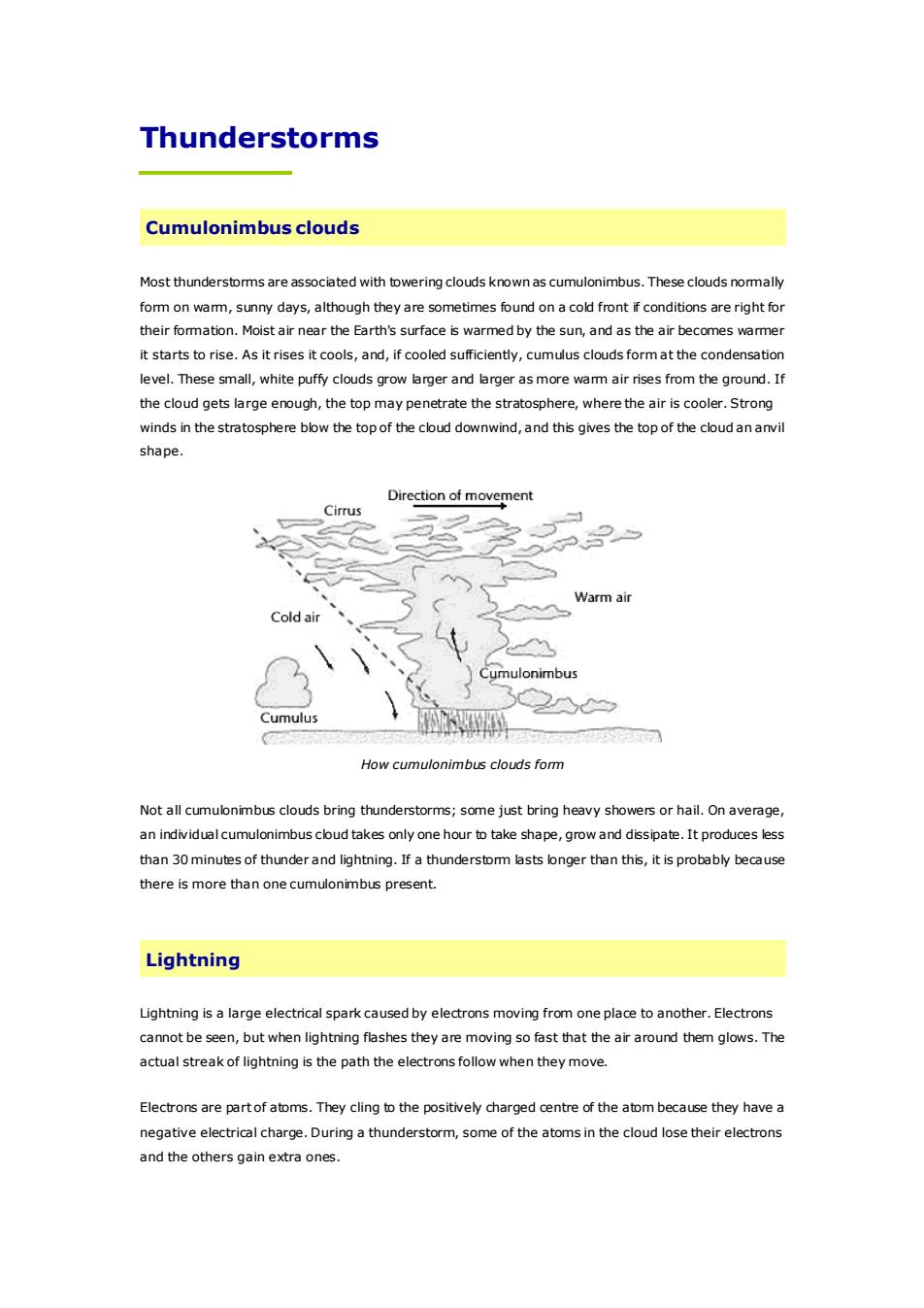
ThunderstormsCumulonimbuscloudsMostthunderstormsareassociatedwithtoweringcloudsknownascumulonimbus.Thesecloudsnormallyformonwarm,sunnydays,althoughtheyaresometimesfoundona coldfront if conditionsarerightfortheirfomation.Moistair nearthe Earth's surfaceiswarmedbythesun,andastheairbecomes wamerit starts to rise. As it rises it cools, and, if cooled sufficiently, cumulus clouds form at the condensationlevel.These small,whitepuffyclouds growlargerand largerasmore warm air rises from theground.Ifthe cloud gets large enough,the top may penetrate the stratosphere, where the air is cooler.Strongwindsinthestratosphereblowthetopoftheclouddownwind,andthisgivesthetopofthecloudananvilshape.DirectionofmovementCirrusWarm airCold airumulonimbusCumulusHowcumulonimbuscloudsformNotall cumulonimbus clouds bring thunderstorms; some just bring heavy showers or hail.On average,an individual cumulonimbus cloud takes only one hour to take shape, grow and dissipate. It produces lessthan 30 minutes of thunder and lightning. If a thunderstom lasts longer than this, it is probably becausethereismorethanonecumulonimbuspresentLightningLightningisalargeelectricalsparkcausedbyelectronsmovingfromoneplacetoanother.Electronscannot be seen, but when lightning flashes they are moving so fast that the air around them glows. Theactual streakoflightning isthepaththeelectronsfollowwhentheymoveElectrons are partof atoms. They cling to the positively charged centre of the atom because they have anegative electrical charge.During a thunderstorm, some of the atoms in the cloud lose their electronsand the others gain extra ones
Thunderstorms Cumulonimbus clouds Most thunderstorms are associated with towering clouds known as cumulonimbus. These clouds normally form on warm, sunny days, although they are sometimes found on a cold front if conditions are right for their formation. Moist air near the Earth's surface is warmed by the sun, and as the air becomes warmer it starts to rise. As it rises it cools, and, if cooled sufficiently, cumulus clouds form at the condensation level. These small, white puffy clouds grow larger and larger as more warm air rises from the ground. If the cloud gets large enough, the top may penetrate the stratosphere, where the air is cooler. Strong winds in the stratosphere blow the top of the cloud downwind, and this gives the top of the cloud an anvil shape. How cumulonimbus clouds form Not all cumulonimbus clouds bring thunderstorms; some just bring heavy showers or hail. On average, an individual cumulonimbus cloud takes only one hour to take shape, grow and dissipate. It produces less than 30 minutes of thunder and lightning. If a thunderstorm lasts longer than this, it is probably because there is more than one cumulonimbus present. Lightning Lightning is a large electrical spark caused by electrons moving from one place to another. Electrons cannot be seen, but when lightning flashes they are moving so fast that the air around them glows. The actual streak of lightning is the path the electrons follow when they move. Electrons are part of atoms. They cling to the positively charged centre of the atom because they have a negative electrical charge. During a thunderstorm, some of the atoms in the cloud lose their electrons and the others gain extra ones
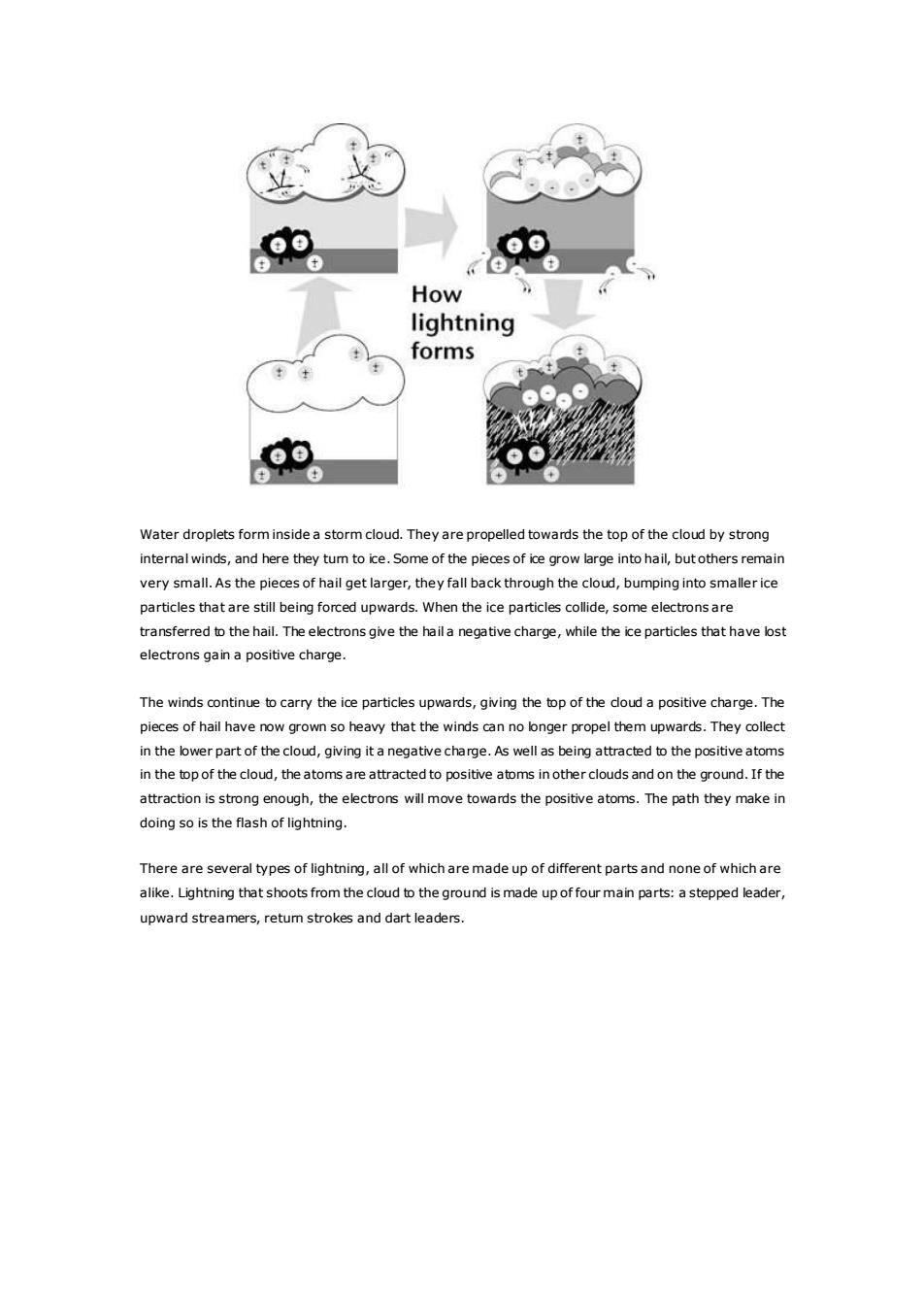
+AHowlightningformsWater droplets form inside a storm cloud.They arepropelled towards the top of the cloud by stronginternalwinds,andheretheytumtoice.Someofthepiecesof icegrowlargeintohail,butothersremainvery small.As the pieces of hail get larger,theyfall back through the cloud, bumping into smallericeparticles that are still being forced upwards.When the ice particles collide, some electrons aretransferred to the hail. The electrons give the haila negative charge, while the ice particles that have lostelectronsgainapositivecharge.The winds continue to carry the ice particles upwards, giving the top of the cloud a positive charge. Thepieces of hail have now grown so heavy that the winds can no longer propel them upwards. They collectin the lower part of the cloud, giving it a negative charge.As well as being attracted to the positive atomsin the top of the cloud, the atoms are attracted to positive atoms in otherclouds and on the ground.If theattraction is strong enough,theelectrons willmovetowards thepositiveatoms.Thepath theymake indoing so istheflashof lightning.There are several types of lightning,all of whicharemadeup of different parts and none of which arealike.Lightning that shoots fromthecloud to theground is made up offourmain parts:a stepped leader,upwardstreamers,retumstrokesanddartleaders
Water droplets form inside a storm cloud. They are propelled towards the top of the cloud by strong internal winds, and here they turn to ice. Some of the pieces of ice grow large into hail, but others remain very small. As the pieces of hail get larger, they fall back through the cloud, bumping into smaller ice particles that are still being forced upwards. When the ice particles collide, some electrons are transferred to the hail. The electrons give the hail a negative charge, while the ice particles that have lost electrons gain a positive charge. The winds continue to carry the ice particles upwards, giving the top of the cloud a positive charge. The pieces of hail have now grown so heavy that the winds can no longer propel them upwards. They collect in the lower part of the cloud, giving it a negative charge. As well as being attracted to the positive atoms in the top of the cloud, the atoms are attracted to positive atoms in other clouds and on the ground. If the attraction is strong enough, the electrons will move towards the positive atoms. The path they make in doing so is the flash of lightning. There are several types of lightning, all of which are made up of different parts and none of which are alike. Lightning that shoots from the cloud to the ground is made up of four main parts: a stepped leader, upward streamers, return strokes and dart leaders
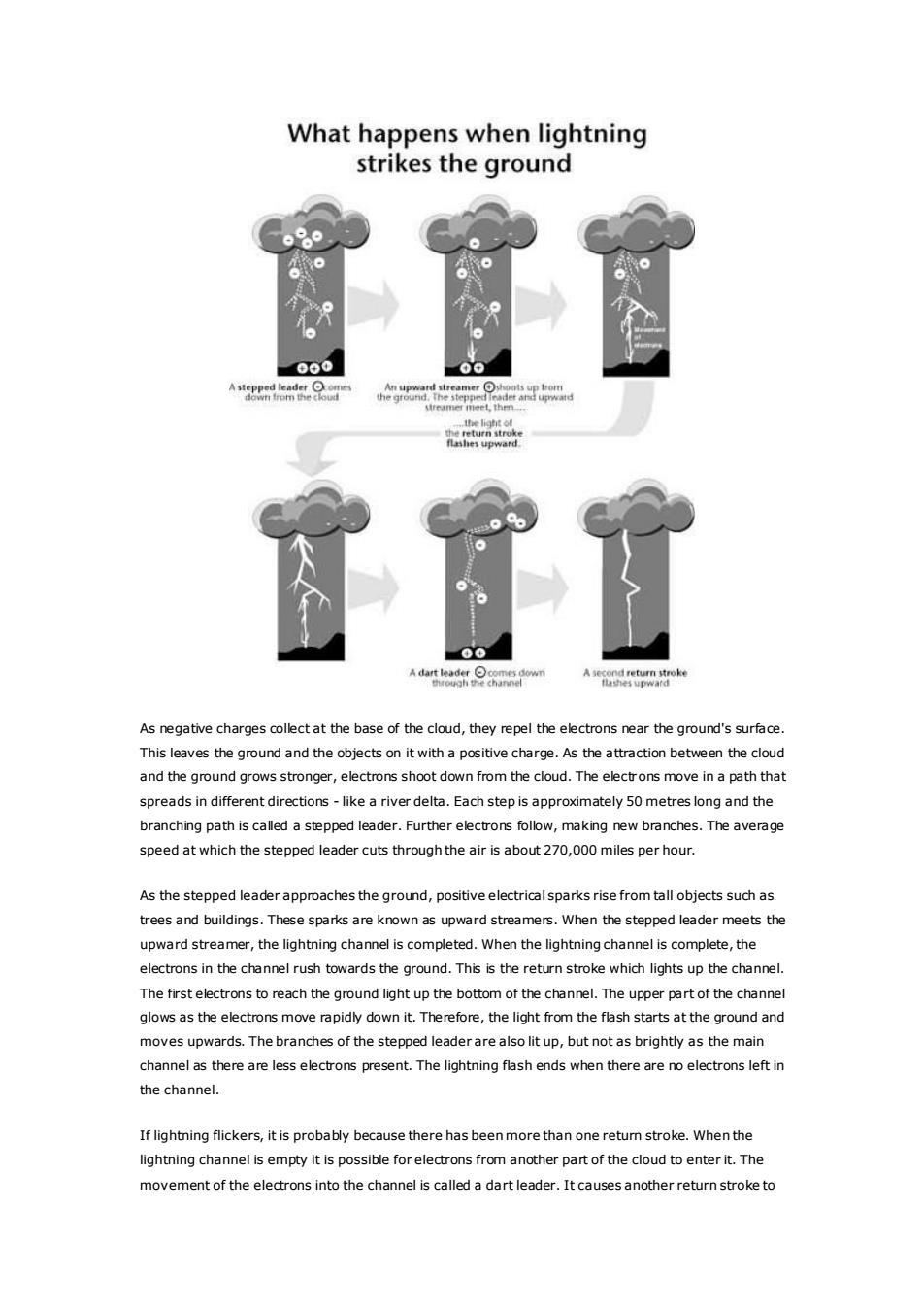
Whathappens when lightningstrikestheground05Astepped leaderOromnupwatdstreamerOshontsupowiromecoudtatdupwateteliattoffashesupwardAdartleaderOconndreturnstrokEthroughthecharnelfashesupwardAsnegativechargescollectatthebaseofthecloud,theyrepel theelectronsneartheground'ssurface.Thisleavesthegroundandtheobjectsonitwithapositivecharge.Astheattractionbetweenthecloudandthegroundgrowsstronger,electronsshootdownfromthecloud.Theelectronsmoveinapaththatspreads in different directions-likea river delta.Eachstep isapproximately50metres long andthebranching path is called a stepped leader.Further electronsfollow,makingnewbranches.The averagespeed at which the stepped leader cuts through the air is about 27o,ooo miles per hour.Asthestepped leaderapproachestheground,positiveelectricalsparksrisefromtallobjectssuchastrees and buildings. These sparks are known as upward streamers. When the stepped leader meets theupward streamer,the lightning channel is completed.When the lightning channel is complete,theelectronsinthechannelrushtowardstheqround.Thisisthereturnstrokewhichlightsupthechannel.The first electrons to reach the ground light up the bottom of the channel.The upper partof the channelglows as the electrons moverapidly down it.Therefore, the light from the flash starts atthe ground andmoves upwards.The branches ofthe stepped leaderarealso lit up,but notas brightly as themainchannel as there are less electrons present. The lightning flash ends when there are no electrons left inthe channel.If lightning flickers, it isprobablybecausetherehas beenmorethanone return stroke.Whenthelightningchannel is empty it ispossibleforelectrons from anotherpartof thecloud to enterit.Themovementoftheelectronsintothechannel iscalled adartleader.Itcausesanotherreturnstroketo
As negative charges collect at the base of the cloud, they repel the electrons near the ground's surface. This leaves the ground and the objects on it with a positive charge. As the attraction between the cloud and the ground grows stronger, electrons shoot down from the cloud. The electrons move in a path that spreads in different directions - like a river delta. Each step is approximately 50 metres long and the branching path is called a stepped leader. Further electrons follow, making new branches. The average speed at which the stepped leader cuts through the air is about 270,000 miles per hour. As the stepped leader approaches the ground, positive electrical sparks rise from tall objects such as trees and buildings. These sparks are known as upward streamers. When the stepped leader meets the upward streamer, the lightning channel is completed. When the lightning channel is complete, the electrons in the channel rush towards the ground. This is the return stroke which lights up the channel. The first electrons to reach the ground light up the bottom of the channel. The upper part of the channel glows as the electrons move rapidly down it. Therefore, the light from the flash starts at the ground and moves upwards. The branches of the stepped leader are also lit up, but not as brightly as the main channel as there are less electrons present. The lightning flash ends when there are no electrons left in the channel. If lightning flickers, it is probably because there has been more than one return stroke. When the lightning channel is empty it is possible for electrons from another part of the cloud to enter it. The movement of the electrons into the channel is called a dart leader. It causes another return stroke to
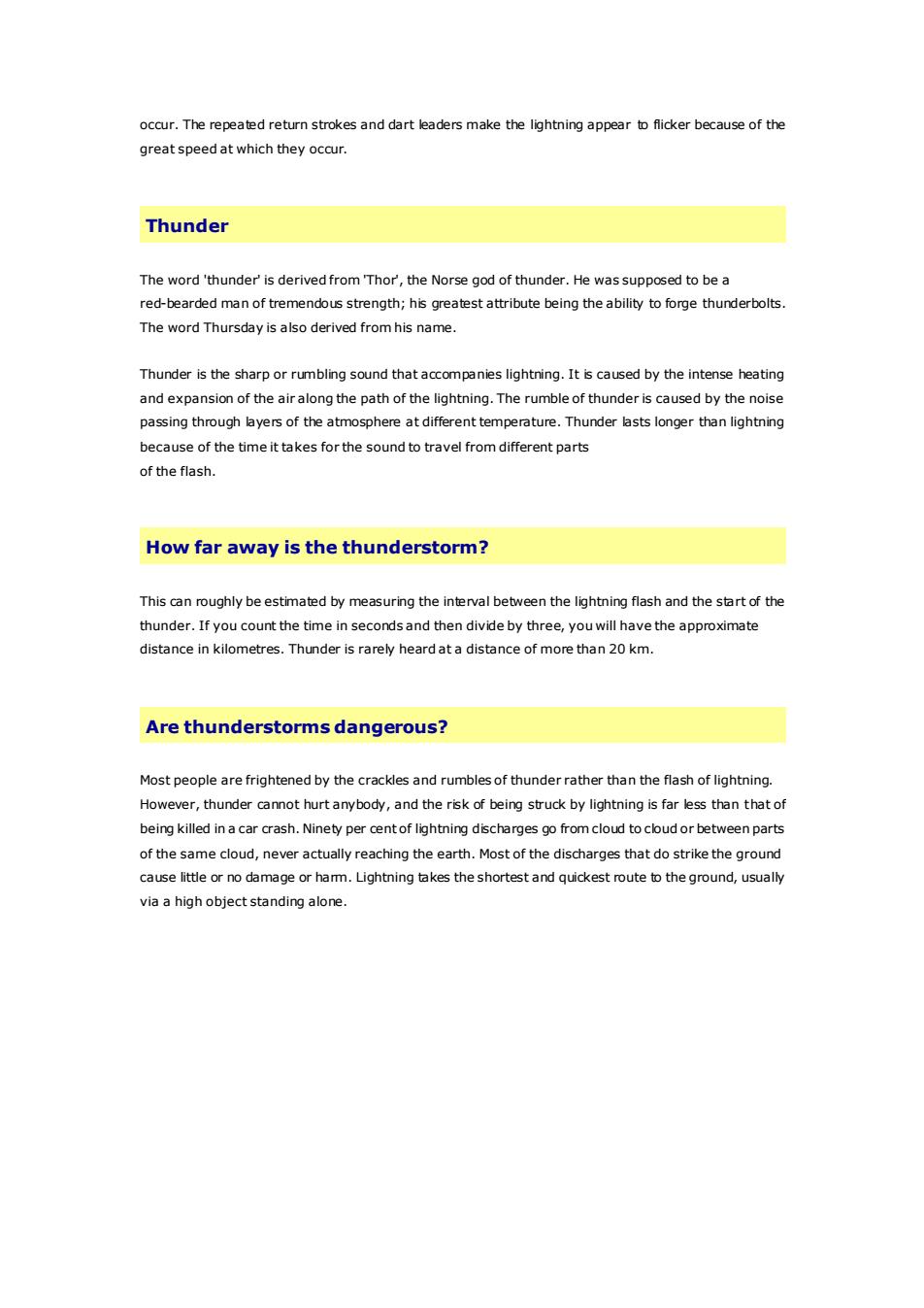
occur.Therepeatedreturnstrokesanddartleadersmakethe lightningappeartoflickerbecauseofthegreatspeedat whichthey occur.ThunderThe word 'thunder' is derivedfrom'Thor,the Norse god of thunder.He was supposed to be ared-bearded man oftremendous strength;his greatest attribute being theability toforge thunderbolts.ThewordThursdayisalsoderived fromhisname.Thunder is the sharp or rumbling sound thataccompanies lightning.It is caused by the intense heatingandexpansion of theairalongthepath of the lightning.The rumbleof thunderis caused bythe noisepassing through layers of the atmosphere at different temperature.Thunder lasts longer than lightningbecauseofthe timeittakes forthe soundtotravel fromdifferentpartsof theflash.How far away is the thunderstorm?This can roughly be estimated by measuring the interval between the lightning flash and the start of thethunder. If you count the time in seconds and then divide by three, you will havethe approximatedistance in kilometres.Thunder is rarely heard ata distance of more than20km.Arethunderstormsdangerous?Most people are frightened by the crackles and rumbles of thunder rather than the flash of lightning.However,thundercannothurtanybody,andtheriskofbeingstruckbylightningisfarlessthanthatofbeing killed in a car crash.Ninety per centof lightning discharges go from cloud to cloud or between partsof the same cloud,never actually reaching the earth.Most of the discharges that do strike the groundcause little or no damage or ham.Lightningtakes the shortestand quickest routeto theground,usuallyvia a high object standing alone
occur. The repeated return strokes and dart leaders make the lightning appear to flicker because of the great speed at which they occur. Thunder The word 'thunder' is derived from 'Thor', the Norse god of thunder. He was supposed to be a red-bearded man of tremendous strength; his greatest attribute being the ability to forge thunderbolts. The word Thursday is also derived from his name. Thunder is the sharp or rumbling sound that accompanies lightning. It is caused by the intense heating and expansion of the air along the path of the lightning. The rumble of thunder is caused by the noise passing through layers of the atmosphere at different temperature. Thunder lasts longer than lightning because of the time it takes for the sound to travel from different parts of the flash. How far away is the thunderstorm? This can roughly be estimated by measuring the interval between the lightning flash and the start of the thunder. If you count the time in seconds and then divide by three, you will have the approximate distance in kilometres. Thunder is rarely heard at a distance of more than 20 km. Are thunderstorms dangerous? Most people are frightened by the crackles and rumbles of thunder rather than the flash of lightning. However, thunder cannot hurt anybody, and the risk of being struck by lightning is far less than that of being killed in a car crash. Ninety per cent of lightning discharges go from cloud to cloud or between parts of the same cloud, never actually reaching the earth. Most of the discharges that do strike the ground cause little or no damage or harm. Lightning takes the shortest and quickest route to the ground, usually via a high object standing alone
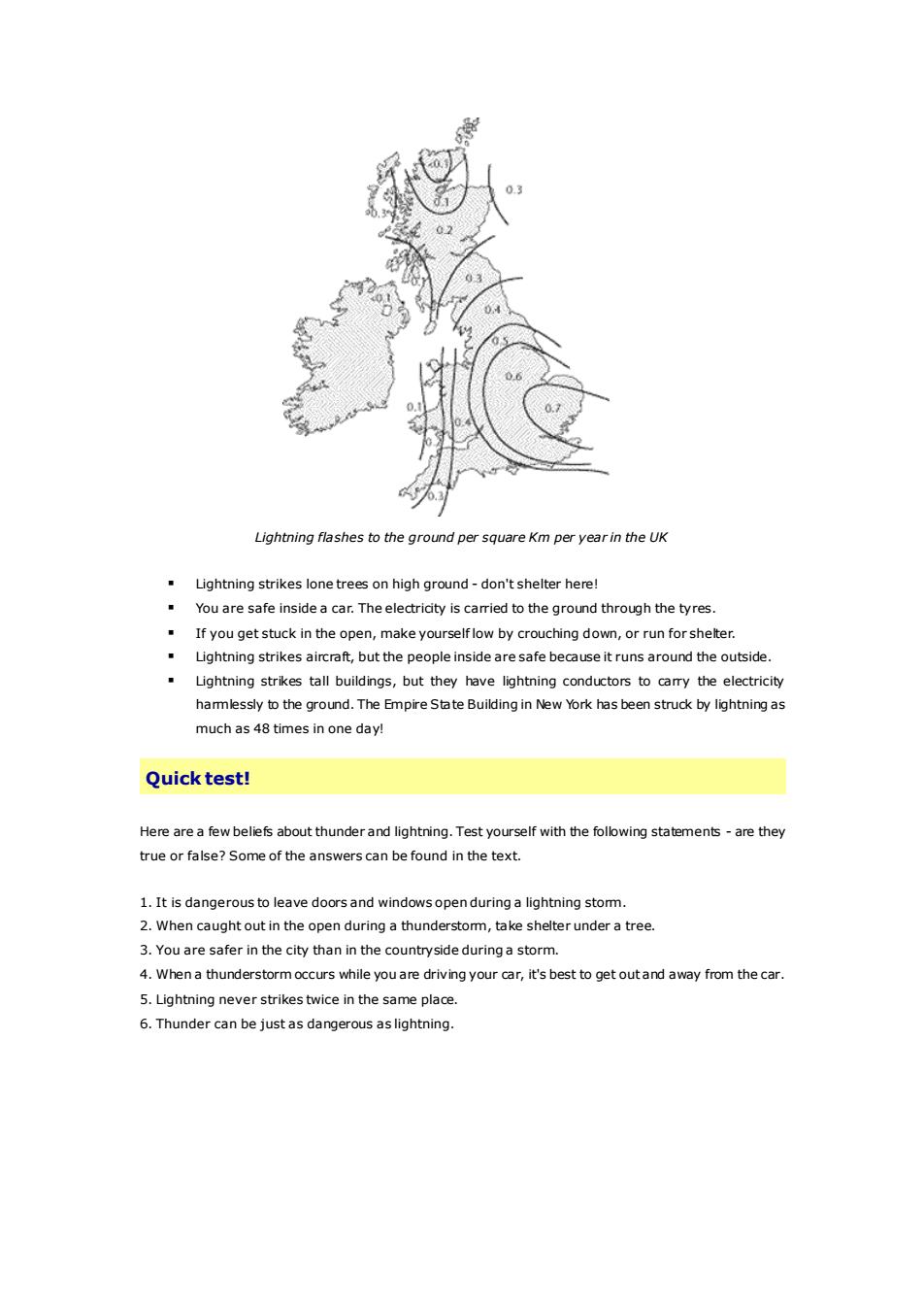
0.3Ao.3LightningflashestothegroundpersquareKmperyearintheUKLightning strikes lonetrees onhighground-don'tshelterhere!+You are safe inside a car. The electricity is carried to the ground through the tyresIf you get stuck in the open, make yourself low by crouching down, or run for shelter.-Lightningstrikesaircraft,butthepeopleinsidearesafebecauseitrunsaroundtheoutside.Lightning strikes tall buildings, but they have lightning conductors to carry the electricityhamlessly to the ground. The Empire State Building in New York has been struck by lightning asmuchas48times inoneday!Quicktest!Here area fewbeliefs about thunderand lightning.Test yourself with the following statements -are theytrue or false? Some of the answers can be found in the text.1.It is dangerous to leave doorsandwindows openduringa lightning storm.2.Whencaughtoutintheopenduringathunderstorm,takeshelterunderatree3. You are safer in the city than in the countryside duringa storm.4. When a thunderstorm occurs while you are driving your car, it's best to get out and away from the car.5. Lightning never strikes twice in the same place.6.Thunder can be justas dangerous aslightning
Lightning flashes to the ground per square Km per year in the UK ▪ Lightning strikes lone trees on high ground - don't shelter here! ▪ You are safe inside a car. The electricity is carried to the ground through the tyres. ▪ If you get stuck in the open, make yourself low by crouching down, or run for shelter. ▪ Lightning strikes aircraft, but the people inside are safe because it runs around the outside. ▪ Lightning strikes tall buildings, but they have lightning conductors to carry the electricity harmlessly to the ground. The Empire State Building in New York has been struck by lightning as much as 48 times in one day! Quick test! Here are a few beliefs about thunder and lightning. Test yourself with the following statements - are they true or false? Some of the answers can be found in the text. 1. It is dangerous to leave doors and windows open during a lightning storm. 2. When caught out in the open during a thunderstorm, take shelter under a tree. 3. You are safer in the city than in the countryside during a storm. 4. When a thunderstorm occurs while you are driving your car, it's best to get out and away from the car. 5. Lightning never strikes twice in the same place. 6. Thunder can be just as dangerous as lightning